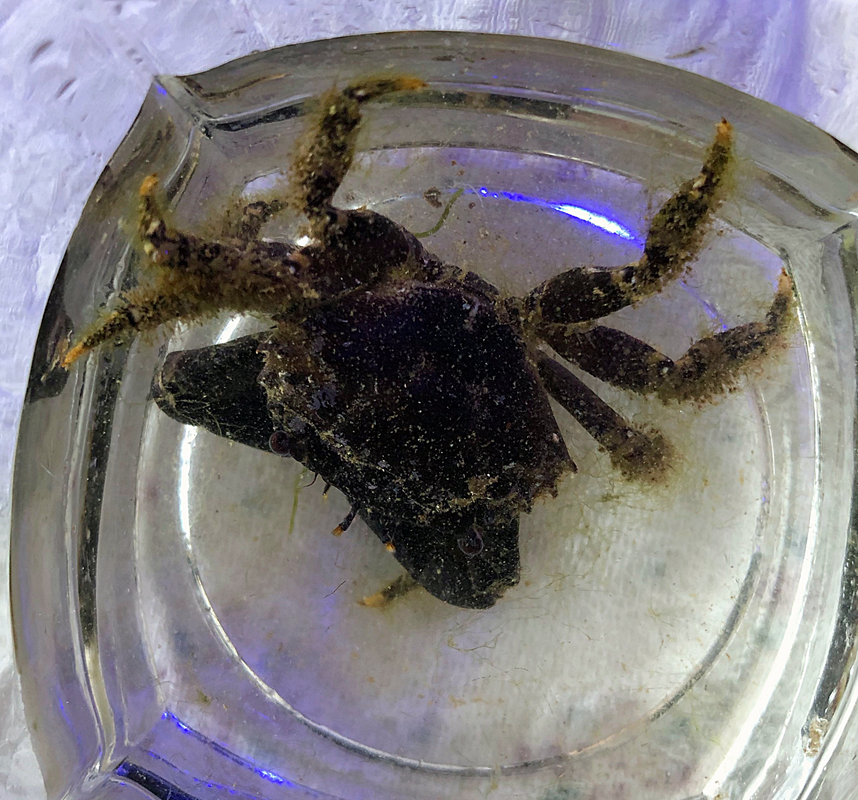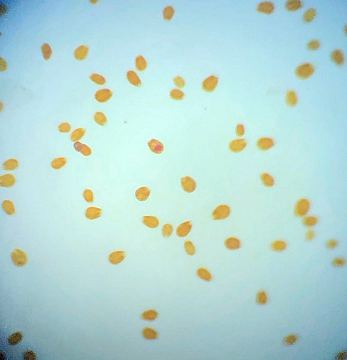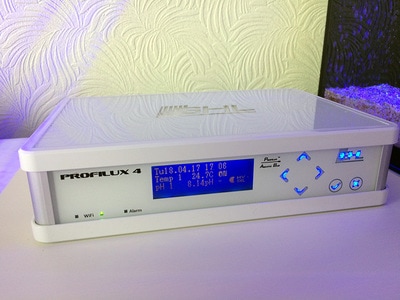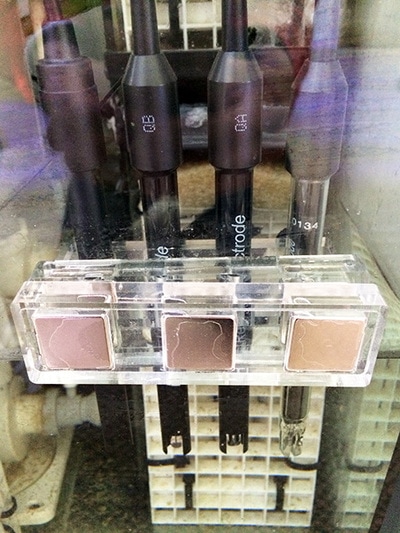|
I have lots to update, hmm where to begin? I think I should probably get the bad stuff out of the way first. Forgive me Father for I have sinned. For quite a while I had noticed that I was harvesting less and less macro algae from the refugium, growth had slowed to almost nothing at all despite there being plenty of nitrate and phosphate available. The days of my tank having low nutrients were certainly in the distant past as they had been slowly but surely creeping up. At the last ICP analysis nitrate was sitting at 11.5mg/l and phosphate at 0.13mg/l. I'd also noted that the mini brittle stars that used to thrive in amongst the algae had dwindled from hundreds to zero (there are still lots in the DT). I'd come to the conclusion that Charlize the hitchhiker crab had been supplementing her diet with some brittle star meat. Anyway hair algae had taken a firm hold in the upper half of the refugium and was choking out the growth of macro algae below. This meant that there was even less algae available to the crustacean residents (Charlize and also Bruce the Emerald crab) at the bottom of the refugium. Then at the beginning of December, I discovered what was left of Bruce, had he also been eaten by Charlize? RIP Bruce. So on the 16th December 2019 I decided then to take the refugium out for a good clean, removing the old mud substrate and replacing it with some new, a long overdue task I must admit. I carefully salvaged as much of the macro algae as I could (a mix of Caulerpa racemosa and Chaetomorpha) and placed it, along with the naughty Charlize, into a bucket (with tank water obviously). I then disconnected the refugium and set about cleaning it. Once everything was clean(ish) I added a new layer of mud, refitted the refugium and carefully filled with water. After a while I reintroduced the macro algae and crab. So far so good, however things were about to take an unfortunate downward turn. It seems that by cleaning the refugium and/or replacing the mud I had altered the water chemistry and not in a good way either. The redox value dropped to 250mV and stayed there. Under normal circumstances the redox probe reads somewhere between 350mV to 450mV and to be honest I don't pay that much attention to it. The numbers bounce around depending on whether I've just fed the fish or done a water change. A value of 250mV however was definitely not normal. I wondered if the probe was reading accurately so I cleaned and recalibrated it but still the readings remained low. A few days after cleaning I noticed some suspicious looking brown algae starting to appear in the refugium and I just knew this wasn't going to be good. Sure enough after about a week or so I started to see signs of it appear in the DT too. It began by coating the gorgonians, the Plexaurella was particularly affected and closed up. Ten days after cleaning I discovered Charlize the hitchhiking crab dead in the refugium. Nooo! I couldn't believe it and felt so terrible guilty. Why did she die? My immediate thought was that the brown algae may have been the cause as some species of dinoflagellates are know to be toxic. I've have not been unfortunate enough to have to deal with this type of algae before but I've certainly read about it a lot. It looked just like typical dinoflagellates, brown and snotty with trapped air bubbles but just to be sure I took a sample and dusted off the microscope. My suspicions sadly proved correct. The tiny oval protozoans were swimming in a circular motion around an anchor point like a tetherball which is typical of Ostreopsis sp., this is indeed toxic to snails and other herbivorous creatures. I've read many horror stories regarding dinoflagellates in reef tanks, so to say I was feeling depressed was a bit of an understatement, I had visions of all my corals covered with brown snot and the sand littered with shells of dead snails.
According to my research there is no easy way to rid a tank of dinoflagellates and I certainly wasn't keen on the idea of performing a 5-7 day black out. I decided not to panic and continue tank maintenance as normal. I continued with the weekly water changes (yes I know these were not advised) and siphon out as much of the 'snot' as possible in an effort to give the gorgonians a tiny bit of relief. I don't know if it helped them but it certainly made me feel better. In the ensuing days the dinos spread to the tips of the Seriatopora hystrix but surprisingly nothing else seemed affected. Every morning I would count the number of snails to make sure they were all still present and correct. The redox level remained very low so on the 14th January I sent off a sample of water for ICP analysis just to check if the mud was leeching out something nasty but as you can see from the link below the results looked OK. Nitrates and phosphates were lower than the previous test but not that low. lab.atiaquaristik.com/share/6bba53665864d463b982 Since I'd effectively removed most of the beneficial bacteria and critters from the refugium (except for amphipods and mysid shrimps) I decided it might be a good idea to add some diversity back in the form of some live rock rubble. This proved easier said than done as nobody seems to stock actual live rock anymore, it's all artificial or dead rock and bottled bacteria these days. I tried ordering some in from a local shop but when I went to collect it, it was just a bag of dry rock, sigh! In the end I located an online shop that was out of stock but expecting a fresh delivery of Australian live rock in the next few weeks or so. I decided to preorder a small amount and crossed my fingers that it wouldn't take too long. In the meantime the redox gradually started to creep back up again and by the end of January it had hit 350mV once more, the gorgonians started to pick up again. The first to bounce back was the Muricea followed by the Pinnigorgia and finally after over a month of looking completely dead the Plexaurella shed a layer of algae/mucus and the polyps came back out again, sadly a couple of branches had stripped but at least some of it was still alive. I also only had to frag off one of the Seriatopora branch tips and the rest bounced back in no time at all. As of today the dinoflagellates have almost completely disappeared from the DT, if you check the Pinnigorgia very closely there is still some evidence of some thin brown strings in one area of low flow but there's not much left at all. I am hoping in another month or so it will have gone altogether, I have my fingers crossed. Oh and just as things were starting to look up I received acknowledgement that my small order of live rock was available and ready for delivery (20th February 2019). That story will have to wait until another post, oh the stress is never ending....
0 Comments
....probably, lol! After waiting absolutely ages for delivery I was finally able to set up my shiny new GHL Profilux 4 controller over Easter. The hope is that when the time comes I can monitor the tank whilst I'm away, so less worry for me. At the moment I just have it set up with four probes measuring temperature, pH, redox and conductivity. There is just 0.1 degree Celsius difference in temperature readings between the digital GHL probe and the Simplyaquaria temperature controller which is pretty good going considering the price difference between the two. I am going to keep the Simplyaquaria controller running as a backup to the GHL, two alarms are better than one in my books. I may actually move the Simplyaquaria probe to the DT so that I have two separate temperature readings to compare. The conductivity of the tank water measured by the GHL probe was 51.8mS which converts to a specific gravity of 1.0257. My calibrated refractometer measured it to be 1.026, again the values are pretty close which is good. I am happy to know that I've been maintaining a suitable salinity using the refractometer. I never bothered to purchase a pH test kit this time round so I had no idea what the actual pH readings were going to be. The levels are fluctuating between 8-8.2 or thereabouts, I would like to study the whole 24hr cycle but haven't managed to work out how to access data from the Profilux yet (if indeed it's actually possible to do). The redox probe is still bedding in, to be honest I'm not really sure what to expect from the readings as I've never used one before. It came with the set so I thought it'd be interesting to set it up and investigate what it can tell me about the tank. On the livestock front, Charlie the hitchhiking hermit crab is now on borrowed time after his first tank misdemeanor yesterday. He knocked my prize Acropora gomezi frag off the rock in his quest for food. I supposed I should be pleased that he just wanted to graze off the rocks and not eat the coral but still it's annoying. He's really quite big now so I'm sure that he'll cause more trouble in the future if I don't try and catch him now.
I think the T. nudus gobies have spawned again, Hop has been sequestered in the cave for the last two days and Skip won't let him out to feed, so I'm hopeful that there are eggs hidden inside. I hope I actually get to see some fry this time round, pretty please! The Cardinals also appear to be courting but there's been no further release of eggs. |
AuthorHi, my name is Lisa and I live in Derby, UK. I am a self-confessed reefaholic! Archives
July 2022
Categories
All
|




 RSS Feed
RSS Feed
